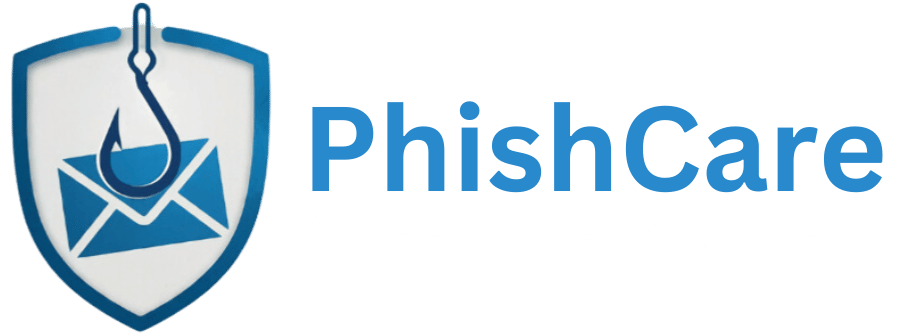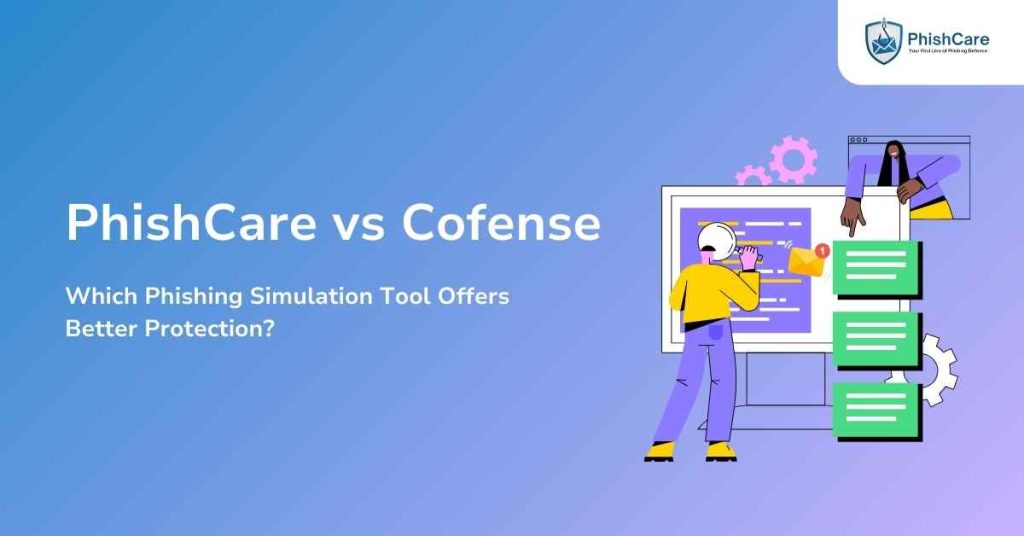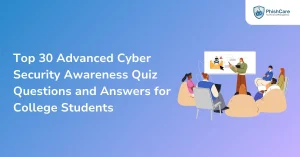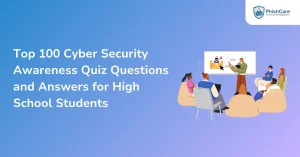Phishing attacks remain one of the most effective methods for cybercriminals to infiltrate organizations. This persistent threat necessitates robust security measures, particularly in the realm of employee education.
Phishing simulation tools play a crucial role in enhancing an organization’s defense against these attacks by testing employee responses to phishing attempts in a controlled environment.
Two prominent players in this space are phishcare vs cofense. In this article, we will explore both platforms in-depth, comparing their features, effectiveness in phishing protection, user experience, and overall value to help organizations determine which tool might be better suited for their needs.
What is a Phishing Simulation Tool?
A phishing simulation tool mimics real phishing attacks to test employee awareness and response to cybersecurity threats.
These tools help organizations train their employees by simulating phishing scenarios, tracking responses, and providing targeted training to improve security awareness.
Why Use a Phishing Simulation Tool?
Phishing simulation tools help organizations strengthen their cybersecurity by proactively testing employees’ ability to recognize and respond to phishing threats.
These tools create realistic phishing scenarios, track user interactions, and provide targeted training to reduce the risk of successful cyberattacks.
1. Training Employees – Simulations help employees recognize phishing attempts and improve their response.
2. Measuring Success – Organizations can analyze how many employees fall for phishing attempts and identify areas needing improvement.
3. Enhancing Security Posture – By addressing vulnerabilities, organizations strengthen their defense mechanisms.
4. Meeting Compliance Requirements – Many industries mandate cybersecurity training, and phishing simulations help ensure compliance.
PhishCare vs Cofense: Phishing Simulation Tool Comparison
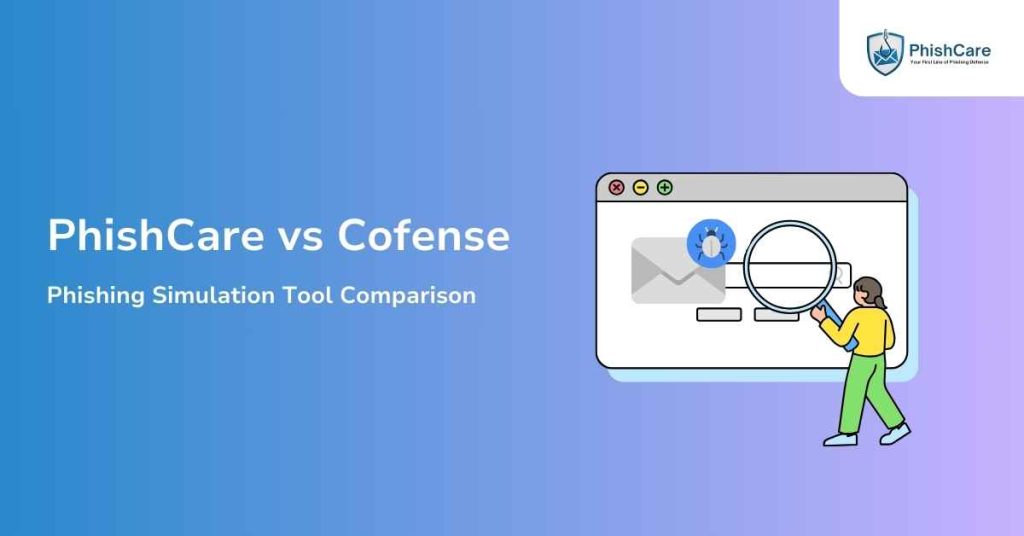
Choosing the right phishing simulation tool is crucial for strengthening an organization’s cybersecurity posture. PhishCare and Cofense are two leading solutions, each offering unique features to train employees, track phishing attempts, and improve awareness. This comparison highlights their differences to help organizations make an informed decision.
PhishCare: Best Phishing Simulation Tool
PhishCare is a phishing protection solution that integrates threat detection, employee training, and comprehensive tracking.
Benefits of PhishCare
1. End-to-End Tracking – Monitors employee engagement and training effectiveness.
2. Fully Customizable Templates – Offers pre-built and customizable templates.
3. In-Depth Reporting – Tracks user performance and identifies weak points.
4. Spear-Phishing Capabilities – Simulates targeted phishing attacks for higher realism.
5. Follow-Up Training – Provides continuous education to employees.
6. Security Checkpoint – Uses targeted assessments to strengthen awareness.
Why PhishCare is the Best Phishing Simulation Tool!

- Customizable Templates
- Awareness Module
- Assessment Test
- Comprehensive Tracking
- Graphical Dashboard Access
- Campaign Report
- Custom Domain Integration
Cutting-Edge Features of PhishCare
PhishCare is a phishing protection solution that integrates threat detection, employee training, and comprehensive tracking.
1. Track Phishing Simulation Progress
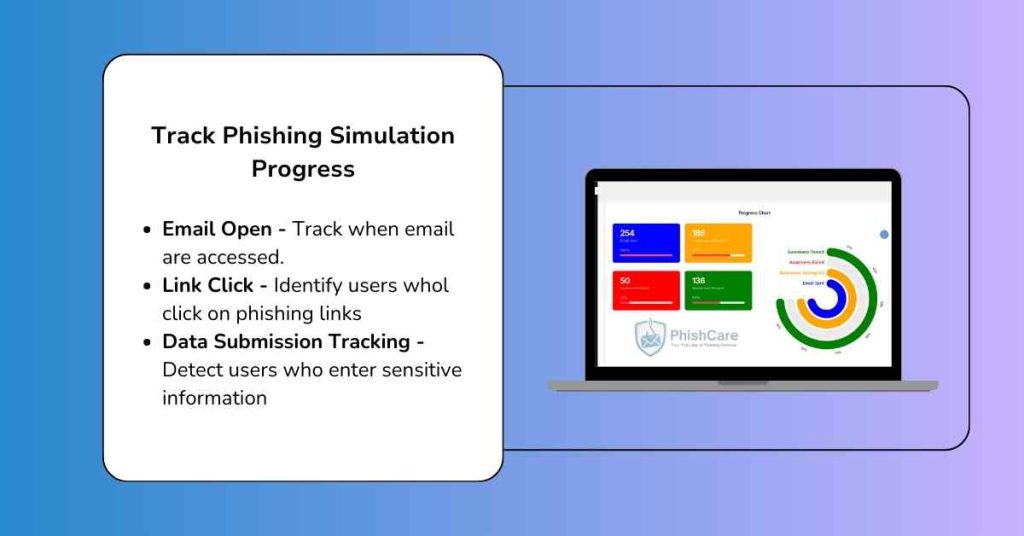
Monitor phishing campaigns in real time and optimize security training with PhishCare.
- Email Open – Track when emails are accessed.
- Link Click – Identify users who click on phishing links.
- Data Submission Tracking – Detect users who enter sensitive information.
2. Awareness Training & Assessment

Empower employees with interactive training and comprehensive assessments.
- Training Alerts – Instantly notify employees with awareness emails.
- Awareness Training Modules – Educate employees with focused videos and phishing assessments.
- Performance Tracking – Measure engagement, assessment scores, and training completion tracking.
3. Comprehensive Reporting
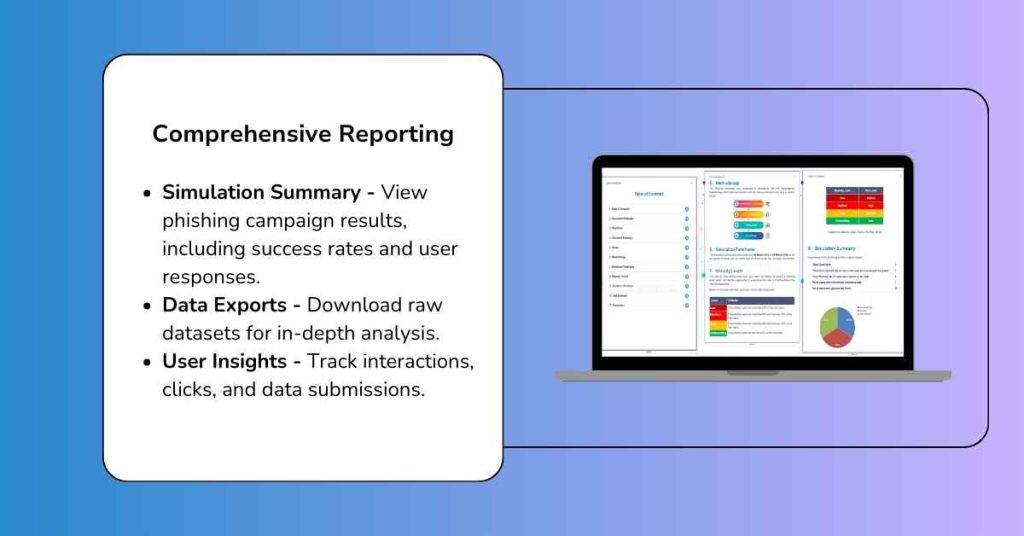
Gain valuable insights into your phishing simulation campaigns with comprehensive reports that help organizations improve their cybersecurity posture.
- Simulation Summary – View phishing campaign results, including success rates and user responses.
- Data Exports – Download raw datasets for in-depth analysis.
- User Insights – Track interactions, clicks, and data submissions.
5. Customizable Templates
Users can customize email and landing page templates to replicate real phishing attacks or specific scenarios. This feature enables realistic training, testing user responses, and improving threat detection in controlled environments.
6. Assessment Test
Following awareness modules, assessments are provided to evaluate users’ understanding. These assessments may include quizzes or tests to gauge knowledge retention after watching educational videos or completing modules.
7. Custom Domain Integration
The tool supports custom domain integration, allowing users to send phishing emails and host landing pages using their own domain. This adds an additional layer of authenticity to the simulation, increasing the likelihood of user engagement and response.
Cofense
Cofense, formerly known as PhishMe, is a provider of anti-phishing solutions that focus on training employees to recognize and report phishing attempts. Cofense offers a comprehensive suite of tools, including:
1. Phishing Simulations
A variety of realistic phishing simulation scenarios designed to test employees’ responses to different types of attacks.
2. Threat Intelligence
Data-driven insights that help organizations understand the latest phishing trends and tactics.
3. Reporting Mechanisms
Tools for employees to report suspicious emails easily, facilitating a proactive security culture.
4. Educational Content
Access to a library of training materials, videos, and quizzes aimed at reinforcing learning.
Conclusion
In conclusion, both PhishCare and Cofense are robust phishing simulation tools that serve different organizational needs. Cofense excels with its comprehensive training resources and advanced analytics, making it suitable for larger organizations with complex security requirements.
Conversely, PhishCare offers a more customizable and budget-friendly approach, ideal for small to medium-sized enterprises focused on personalized training experiences. Ultimately, the choice between these two tools should be guided by an organization’s specific needs, budget, and overall cybersecurity strategy to ensure optimal protection against phishing threats.
FAQs: Phishcare vs Cofense
1. What is a phishing simulation tool?
Answer: A phishing simulation tool is a software application that mimics real phishing attacks to test and train employees within an organization. It helps assess how well employees can identify and respond to potential phishing threats, ultimately enhancing the organization’s cybersecurity awareness.
2. How do Cofense and PhishCare differ in their approach to phishing simulations?
Answer: Cofense offers a comprehensive suite of phishing simulations, threat intelligence, and robust reporting tools, making it suitable for larger organizations. PhishCare, on the other hand, focuses on customizable simulations and ongoing training modules, catering to small and medium-sized businesses that need a straightforward, adaptable solution.
3. Can phishing simulation tools help reduce the number of successful phishing attacks?
Answer: Yes, research indicates that phishing simulation tools can significantly reduce the likelihood of successful attacks. By training employees to recognize phishing threats and encouraging them to report suspicious emails, organizations can enhance their overall security posture.
4. What types of phishing scenarios do these tools typically simulate?
Answer: Both tools typically simulate various phishing scenarios, including standard phishing emails, spear phishing, whaling attacks, and smishing (SMS phishing) to replicate real-world threats employees might encounter.
5. How often should organizations conduct phishing simulations?
Answer: Organizations should ideally conduct phishing simulations regularly, such as quarterly or semi-annually, while also providing ongoing training to keep security awareness fresh and relevant as new phishing tactics emerge.
6. What kind of reporting features do these tools offer?
Answer: Both Cofense and PhishCare provide detailed reporting features that track employee performance during simulations, analyze phishing susceptibility trends, and offer insights into areas needing improvement, helping organizations tailor their training initiatives more effectively.
7. Do these tools offer training materials for employees?
Answer: Yes, both Cofense and PhishCare include educational content designed to enhance employee understanding of phishing threats. This may include videos, quizzes, articles, and interactive modules that help reinforce learning after simulations.
8. Is it possible to customize phishing simulation scenarios?
Answer: Yes, PhishCare allows for significant customization of simulation scenarios to fit specific organizational contexts. Cofense also offers a variety of simulation templates that can be tailored to target different audience groups within the organization.
9. How do these tools integrate with existing security systems?
Answer: Both Cofense and PhishCare offer integration capabilities with other cybersecurity tools such as SIEM systems, email security solutions, and ticketing systems, enabling organizations to create a more comprehensive security infrastructure.
10. Which tool is better for a small company: Cofense or PhishCare?
Answer: While both tools can be beneficial for small companies, PhishCare may be a better fit due to its focus on affordable, customizable training and straightforward implementation. However, if a small company anticipates rapid growth and complex security needs in the future, considering Cofense might also be worthwhile for its extensive features and support.
